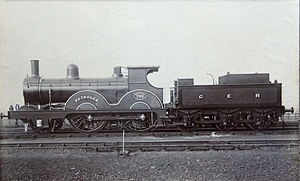GER Class T19
| GER Class T19 |

Oil-burning T19 No. 760 named Petrolea. The name was removed when it was rebuilt circa 1902–1904
|
|
|
| Specifications |
Configuration:
|
|
| • Whyte
|
2-4-0 |
| • UIC
|
1B n2 |
| Gauge |
4 ft 8 1⁄2 in (1,435 mm) |
| Leading dia. |
4 ft 0 in (1.219 m) |
|
Driver dia. |
7 ft 0 in (2.134 m) |
| Wheelbase |
36 ft 7 in (11.15 m) |
| Length |
48 ft 2 in (14.68 m) over buffers |
| Adhesive weight |
27 long tons 11 cwt (61,700 lb or 28 t) |
| Loco weight |
42 long tons 0 cwt (94,100 lb or 42.7 t) |
| Fuel type |
Coal, some converted to fuel oil |
Firebox:
• Firegrate area |
18 sq ft (1.7 m2) |
| Boiler pressure |
160 lbf/in2 (1.10 MPa) |
| Heating surface |
1,199.5 sq ft (111.44 m2) |
| Cylinders |
Two, inside |
| Cylinder size |
18 in × 24 in (457 mm × 610 mm) |
|
|
|
| Career |
| Operators |
Great Eastern Railway |
| Nicknames |
Standards |
| Withdrawn |
1902–1908 (for rebuilding)
1908–1913 (for scrapping) |
| Disposition |
29 scrapped,
21 rebuilt as "Humpty-Dumpties",
60 rebuilt as 4-4-0 |
|
| Specifications |
Configuration:
|
|
| • Whyte
|
2-4-0 |
| • UIC
|
1B n2 |
| Gauge |
4 ft 8 1⁄2 in (1,435 mm) |
| Leading dia. |
4 ft 0 in (1.219 m) |
|
Driver dia. |
7 ft 0 in (2.134 m) |
| Wheelbase |
36 ft 7 in (11.15 m) |
| Length |
48 ft 2 in (14.68 m) over buffers |
| Adhesive weight |
27 long tons 11 cwt (61,700 lb or 28 t) |
| Loco weight |
42 long tons 0 cwt (94,100 lb or 42.7 t) |
| Fuel type |
Coal, some converted to fuel oil |
Firebox:
• Firegrate area |
18 sq ft (1.7 m2) |
| Boiler pressure |
160 lbf/in2 (1.10 MPa) |
| Heating surface |
1,199.5 sq ft (111.44 m2) |
| Cylinders |
Two, inside |
| Cylinder size |
18 in × 24 in (457 mm × 610 mm) |
| Career |
| Operators |
Great Eastern Railway |
| Nicknames |
Standards |
| Withdrawn |
1902–1908 (for rebuilding)
1908–1913 (for scrapping) |
| Disposition |
29 scrapped,
21 rebuilt as "Humpty-Dumpties",
60 rebuilt as 4-4-0 |
GER Class T19R
"Humpty Dumpty" |
| Type and origin |
| Only differences from T19 above are shown |
| Power type |
Steam |
| Rebuilder |
Stratford Works |
| Rebuild date |
1902–1904 |
| Number rebuilt |
21 |
|
| Specifications |
| Adhesive weight |
30 long tons 12 cwt (68,500 lb or 31.1 t) |
| Loco weight |
45 long tons 9 cwt (101,800 lb or 46.2 t) |
Firebox:
• Firegrate area |
21.6 sq ft (2.01 m2) |
| Boiler |
Belpaire |
| Boiler pressure |
180 lbf/in2 (1.24 MPa) |
| Heating surface |
1,476.2 sq ft (137.14 m2) |
|
|
|
|
|
| Type and origin |
| Only differences from T19 above are shown |
| Power type |
Steam |
| Rebuilder |
Stratford Works |
| Rebuild date |
1902–1904 |
| Number rebuilt |
21 |
| Specifications |
| Adhesive weight |
30 long tons 12 cwt (68,500 lb or 31.1 t) |
| Loco weight |
45 long tons 9 cwt (101,800 lb or 46.2 t) |
Firebox:
• Firegrate area |
21.6 sq ft (2.01 m2) |
| Boiler |
Belpaire |
| Boiler pressure |
180 lbf/in2 (1.24 MPa) |
| Heating surface |
1,476.2 sq ft (137.14 m2) |
The GER Class T19 was a class of 2-4-0 steam tender locomotives designed by James Holden for the Great Eastern Railway. Some were later rebuilt with larger boilers while others were rebuilt with both larger boilers and a 4-4-0 wheel arrangement. Unusually, both the 2-4-0 and 4-4-0 rebuilds were classified as GER Class T19 Rebuilt. All the 2-4-0s had been withdrawn by 1920 so only the 4-4-0s passed to the London and North Eastern Railway in 1923 and these became the LNER Class D13.
The T19s was similar to the Worsdell Class G14, but had a slightly larger boiler. One hundred and ten locomotives were constructed. They had 18-by-24-inch (457 mm × 610 mm) cylinders and the last ten had 160-pound-force-per-square-inch (1.10 MPa) boilers, but the remainder were gradually fitted with two-ring boilers.
No. 758 was fitted with an extended smokebox in 1900. Oil burning apparatus was fitted to No. 712 and 759–767. No. 760 was named Petrolea. Tenders with water scoops were fitted to Nos. 762–767 and 1030–1039 to enable the Cromer expresses to run non-stop from Liverpool Street to North Walsham from 1 July 1897. Water troughs were installed at Halifax Junction, Ipswich and at Tivetshall St. Mary.
No. 755 hauled the funeral train for the late Prince Albert Victor, Duke of Clarence and Avondale from King's Lynn to Windsor on 28 January 1892. No. 761 hauled the honeymoon train for the late prince's brother and former fiancée the Duke and Duchess of York (later George V and Queen Mary) from Liverpool Street to King's Lynn on 6 July 1893.
...
Wikipedia

